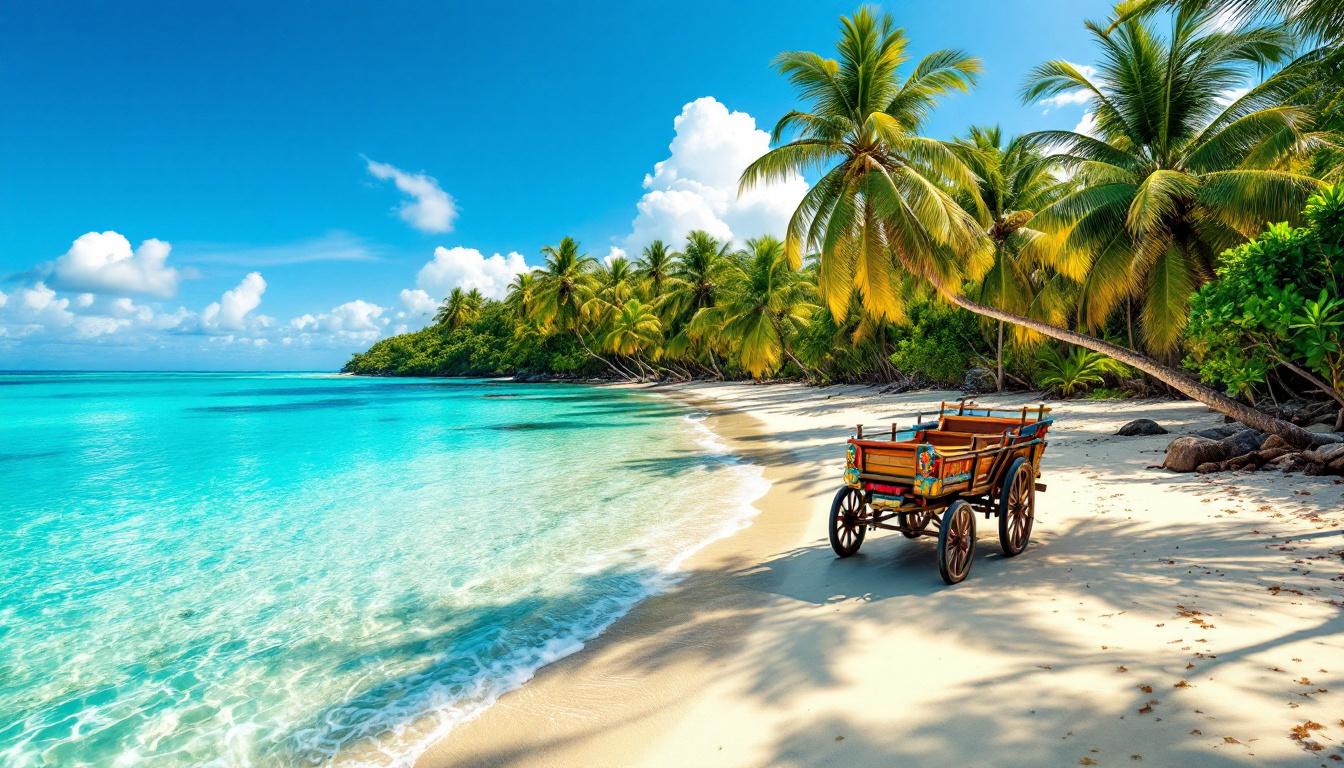While Thailand’s famous islands brace for August monsoons and the Philippines faces stormy seas, Gili Trawangan basks in perfect 82°F weather with virtually zero rainfall. This tiny Indonesian paradise, just 3km long, becomes Southeast Asia’s ultimate escape when its competitors disappear under torrential rains.
At only 3 square kilometers, Gili Trawangan is smaller than Central Park yet offers something no other tropical destination can match in August: guaranteed sunshine paired with complete silence from motorized vehicles. While Koh Phi Phi cancels boat trips and Boracay closes dive shops, this car-free island maintains perfect conditions.
The timing advantage is remarkable. As Thailand’s southwest monsoon dumps 6-12 inches of rain across popular islands, Gili Trawangan records just 14mm of rainfall with only a 6% chance of precipitation. The contrast transforms a simple vacation choice into a strategic weather play.
Perfect timing when competitors struggle
Indonesia’s dry season advantage
August falls within Indonesia’s driest period, with Gili Trawangan experiencing consistent 24-29°C temperatures and minimal humidity. While Thai islands like Koh Samui face disrupted ferry schedules and cloudy skies, this Indonesian gem enjoys 9 hours of daily sunshine and calm seas perfect for diving.
Monsoon chaos elsewhere
Thailand’s west coast becomes virtually inaccessible in August, with Phuket and Koh Phi Phi experiencing rough seas and limited outdoor activities. The Philippines faces similar challenges, making Gili Trawangan’s stable weather patterns incredibly valuable for travelers seeking reliable tropical conditions without gambling on forecasts.
The silence that changes everything
Zero traffic noise guarantee
Unlike any competing destination, Gili Trawangan operates on horse-drawn carts called cidomo and bicycles exclusively. This creates an almost mystical quiet that amplifies the sound of waves and tropical birds. When other islands buzz with scooters and cars, this sanctuary offers pure acoustic bliss.
Cultural transportation heritage
The Sasak fishing community has preserved traditional transport methods that double as cultural experiences. Riding a cidomo between beaches connects visitors to centuries-old island life while supporting local families who’ve maintained these practices despite tourism pressures. It’s transportation as cultural immersion.
Marine conditions peak in dry season
Crystal clear diving visibility
August delivers 27°C sea temperatures with exceptional underwater visibility reaching 25-30 meters. While monsoon-affected waters in Thailand and the Philippines become murky and dangerous for diving, Gili Trawangan’s reefs remain pristine. Whale sharks and sea turtles frequent these protected waters during the dry season.
Calm seas for all activities
When other destinations cancel snorkeling trips and beach activities, Gili Trawangan maintains consistently calm conditions. The absence of monsoon swells means reliable boat transfers, peaceful beach days, and uninterrupted sunset views that Instagram-worthy tropical vacations demand.
Authentic island life without crowds
Local community benefits
The island’s 1,500 residents have created sustainable tourism that preserves their Islamic Sasak culture while welcoming respectful visitors. Traditional fishing boats still work alongside modern dive operations, creating authentic interactions impossible on overdeveloped competitors where local culture gets buried under resort development.
Protected paradise approach
Gili Trawangan’s vehicle restrictions aren’t just environmental policy—they’re cultural preservation. The community actively maintains the peaceful atmosphere that draws travelers seeking authentic island experiences. This protection means visitors encounter genuine local life rather than commercialized tourist performances.
As Thailand’s islands prepare for months of unpredictable weather and the Philippines faces similar monsoon disruption, Gili Trawangan offers guaranteed tropical perfection. The combination of perfect August weather, unique car-free tranquility, and authentic cultural experiences creates an unbeatable value proposition.
Book your escape to this tiny Indonesian paradise while Thailand’s famous islands wait for clearer skies. The weather window is open, the seas are calm, and the cidomo carts are ready to transport you to Southeast Asia’s most peaceful tropical secret—available at this complete Gili Trawangan travel guide.
Planning your perfect weather escape
When should I visit Gili Trawangan for the best weather?
August through October offers the driest conditions with minimal rainfall and consistent sunshine. This timing avoids both Indonesia’s wet season and the monsoons affecting Thailand and the Philippines, making it the perfect weather window for guaranteed tropical conditions.
How do I get around without cars or motorbikes?
The island operates exclusively on cidomo horse-drawn carts and bicycles, creating a unique transportation experience. Most accommodations provide bicycle rentals, while cidomo rides offer cultural immersion with local drivers who share island stories and traditional knowledge.
What makes the diving conditions special in August?
August delivers peak underwater visibility with 27°C water temperatures and calm seas. The dry season means less runoff and sediment, creating crystal-clear conditions perfect for spotting whale sharks, sea turtles, and vibrant coral reefs that thrive in these protected waters.
How does Gili Trawangan compare to overcrowded alternatives?
At just 3 square kilometers, the island maintains intimate scale while offering diverse experiences from peaceful beaches to vibrant nightlife. The vehicle-free policy preserves tranquility impossible on motorized islands, while the strong local community ensures authentic cultural interactions rather than commercialized tourist experiences.
Is Gili Trawangan suitable for sustainable travel?
The island’s car-free transportation system and community-focused tourism model create minimal environmental impact. Local Sasak fishing families benefit directly from respectful tourism, while coral reef protection initiatives maintain the marine ecosystem that makes diving and snorkeling exceptional year-round.
